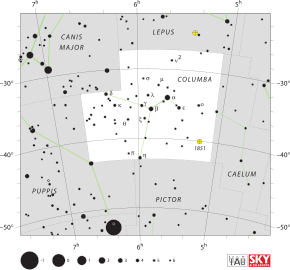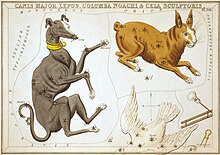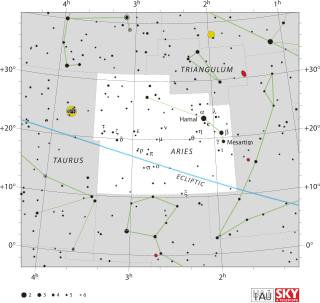
Aries is one of the constellations of the zodiac. It is located in the Northern celestial hemisphere between Pisces to the west and Taurus to the east. The name Aries is Latin for ram. Its old astronomical symbol is (♈︎). It is one of the 48 constellations described by the 2nd century astronomer Ptolemy, and remains one of the 88 modern constellations. It is a mid-sized constellation ranking 39th in overall size, with an area of 441 square degrees.
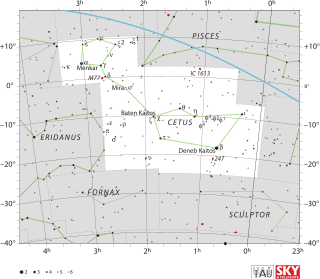
Cetus is a constellation, sometimes called 'the whale' in English. The Cetus was a sea monster in Greek mythology which both Perseus and Heracles needed to slay. Cetus is in the region of the sky that contains other water-related constellations: Aquarius, Pisces and Eridanus.

Carina is a constellation in the southern sky. Its name is Latin for the keel of a ship, and it was the southern foundation of the larger constellation of Argo Navis until it was divided into three pieces, the other two being Puppis, and Vela.

Camelopardalis is a large but faint constellation of the northern sky representing a giraffe. The constellation was introduced in 1612 or 1613 by Petrus Plancius. Some older astronomy books give Camelopardalus or Camelopardus as alternative forms of the name, but the version recognized by the International Astronomical Union matches the genitive form, seen suffixed to most of its key stars.
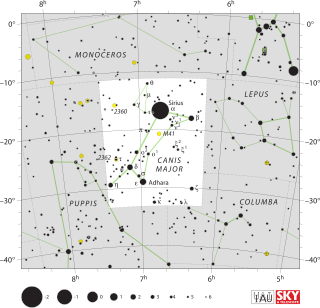
Canis Major is a constellation in the southern celestial hemisphere. In the second century, it was included in Ptolemy's 48 constellations, and is counted among the 88 modern constellations. Its name is Latin for "greater dog" in contrast to Canis Minor, the "lesser dog"; both figures are commonly represented as following the constellation of Orion the hunter through the sky. The Milky Way passes through Canis Major and several open clusters lie within its borders, most notably M41.

Canis Minor is a small constellation in the northern celestial hemisphere. In the second century, it was included as an asterism, or pattern, of two stars in Ptolemy's 48 constellations, and it is counted among the 88 modern constellations. Its name is Latin for "lesser dog", in contrast to Canis Major, the "greater dog"; both figures are commonly represented as following the constellation of Orion the hunter.

Centaurus is a bright constellation in the southern sky. One of the largest constellations, Centaurus was included among the 48 constellations listed by the 2nd-century astronomer Ptolemy, and it remains one of the 88 modern constellations. In Greek mythology, Centaurus represents a centaur; a creature that is half human, half horse. Notable stars include Alpha Centauri, the nearest star system to the Solar System, its neighbour in the sky Beta Centauri, and V766 Centauri, one of the largest stars yet discovered. The constellation also contains Omega Centauri, the brightest globular cluster as visible from Earth and the largest identified in the Milky Way, possibly a remnant of a dwarf galaxy.

Chamaeleon is a small constellation in the deep southern sky. It is named after the chameleon, a kind of lizard. It was first defined in the 16th century.

Dorado is a constellation in the Southern Sky. It was named in the late 16th century and is now one of the 88 modern constellations. Its name refers to the mahi-mahi, which is known as dorado ("golden") in Spanish, although it has also been depicted as a swordfish. Dorado contains most of the Large Magellanic Cloud, the remainder being in the constellation Mensa. The South Ecliptic pole also lies within this constellation.

Equuleus is a faint constellation located just north of the celestial equator. Its name is Latin for "little horse", a foal. It was one of the 48 constellations listed by the 2nd century astronomer Ptolemy, and remains one of the 88 modern constellations. It is the second smallest of the modern constellations, spanning only 72 square degrees. It is also very faint, having no stars brighter than the fourth magnitude.
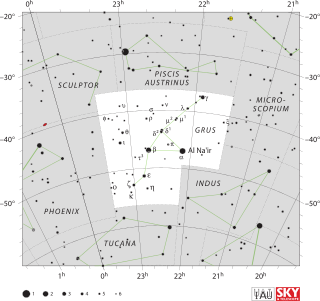
Grus is a constellation in the southern sky. Its name is Latin for the crane, a type of bird. It is one of twelve constellations conceived by Petrus Plancius from the observations of Pieter Dirkszoon Keyser and Frederick de Houtman. Grus first appeared on a 35-centimetre-diameter (14-inch) celestial globe published in 1598 in Amsterdam by Plancius and Jodocus Hondius and was depicted in Johann Bayer's star atlas Uranometria of 1603. French explorer and astronomer Nicolas-Louis de Lacaille gave Bayer designations to its stars in 1756, some of which had been previously considered part of the neighbouring constellation Piscis Austrinus. The constellations Grus, Pavo, Phoenix and Tucana are collectively known as the "Southern Birds".

Hydrus is a small constellation in the deep southern sky. It was one of twelve constellations created by Petrus Plancius from the observations of Pieter Dirkszoon Keyser and Frederick de Houtman and it first appeared on a 35-cm (14 in) diameter celestial globe published in late 1597 in Amsterdam by Plancius and Jodocus Hondius. The first depiction of this constellation in a celestial atlas was in Johann Bayer's Uranometria of 1603. The French explorer and astronomer Nicolas Louis de Lacaille charted the brighter stars and gave their Bayer designations in 1756. Its name means "male water snake", as opposed to Hydra, a much larger constellation that represents a female water snake. It remains below the horizon for most Northern Hemisphere observers.

Octans is a faint constellation located in the deep Southern Sky. Its name is Latin for the eighth part of a circle, but it is named after the octant, a navigational instrument. Devised by French astronomer Nicolas Louis de Lacaille in 1752, Octans remains one of the 88 modern constellations. The southern celestial pole is located within the boundaries of Octans.

Monoceros is a faint constellation on the celestial equator. Its definition is attributed to the 17th-century cartographer Petrus Plancius. It is bordered by Orion to the west, Gemini to the north, Canis Major to the south, and Hydra to the east. Other bordering constellations include Canis Minor, Lepus, and Puppis.

Volans is a constellation in the southern sky. It represents a flying fish; its name is a shortened form of its original name, Piscis Volans. Volans was one of twelve constellations created by Petrus Plancius from the observations of Pieter Dirkszoon Keyser and Frederick de Houtman and it first appeared on a 35-cm (14") diameter celestial globe published in 1597 in Amsterdam by Plancius with Jodocus Hondius. The first depiction of this constellation in a celestial atlas was in Johann Bayer's Uranometria of 1603.

Indus is a constellation in the southern sky first professionally surveyed by Europeans in the 1590s and mapped on a globe by Petrus Plancius by early 1598. It was included on a plate illustrating southern constellations in Bayer's sky atlas Uranometria in 1603. It lies well south of the Tropic of Capricorn but its triangular shape can be seen for most of the year from the Equator. It is elongated from north to south and has a complex boundary. The English translation of its name is generally given as the Indian, though it is unclear which indigenous people the constellation was originally supposed to represent.

Hydra is the largest of the 88 modern constellations, measuring 1303 square degrees, and also the longest at over 100 degrees. Its southern end borders Libra and Centaurus and its northern end borders Cancer. It was included among the 48 constellations listed by the 2nd century astronomer Ptolemy. Commonly represented as a water snake, it straddles the celestial equator.

Eridanus is a constellation in the southern celestial hemisphere. It is represented as a river. One of the 48 constellations listed by the 2nd century astronomer Ptolemy, it remains one of the 88 modern constellations. It is the sixth largest of the modern constellations, and the one that extends farthest in the sky from north to south. The same name was later taken as a Latin name for the real Po River and also for the name of a minor river in Athens.

Delta Canis Majoris, officially named Wezen, is a star in the constellation of Canis Major. It is a yellow-white F-type supergiant with an apparent magnitude of +1.83. Since 1943, the spectrum of this star has served as one of the stable anchor points by which other stars are classified.

Gemini is one of the constellations of the zodiac and is located in the northern celestial hemisphere. It was one of the 48 constellations described by the 2nd century AD astronomer Ptolemy, and it remains one of the 88 modern constellations today. Its name is Latin for twins, and it is associated with the twins Castor and Pollux in Greek mythology. Its old astronomical symbol is (♊︎).
